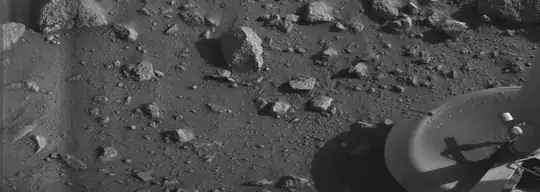When I look at pictures taken by a modern spacecraft (like that one showing the surface of Titan:

and taken by Cassini) I kinda understand how they might be produced. There might be some kind of CCD sensor installed and the data is later transmitted to Earth.
But then I think about it I start to wonder how cameras worked on older spacecrafts like Mariner, for example this one taken by Viking 1
 .
.
As far as I know there were no digital cameras back then. How did they get around it and were able to produce photos and more importantly sent imaging data back to Earth?
I can imagine that there was an analog camera installed along with some scanning facility but that sounds sooo unlikely as it would require a rather complex machinery which isn't feasible for an operation in space. But other than that I'm out of ideas. Wikipedia is surprisingly silent about it, too.
EDIT: Thanks, everybody, for your great answers! I upvoted everything I could and accepted Georg's answer for a great Wiki link.